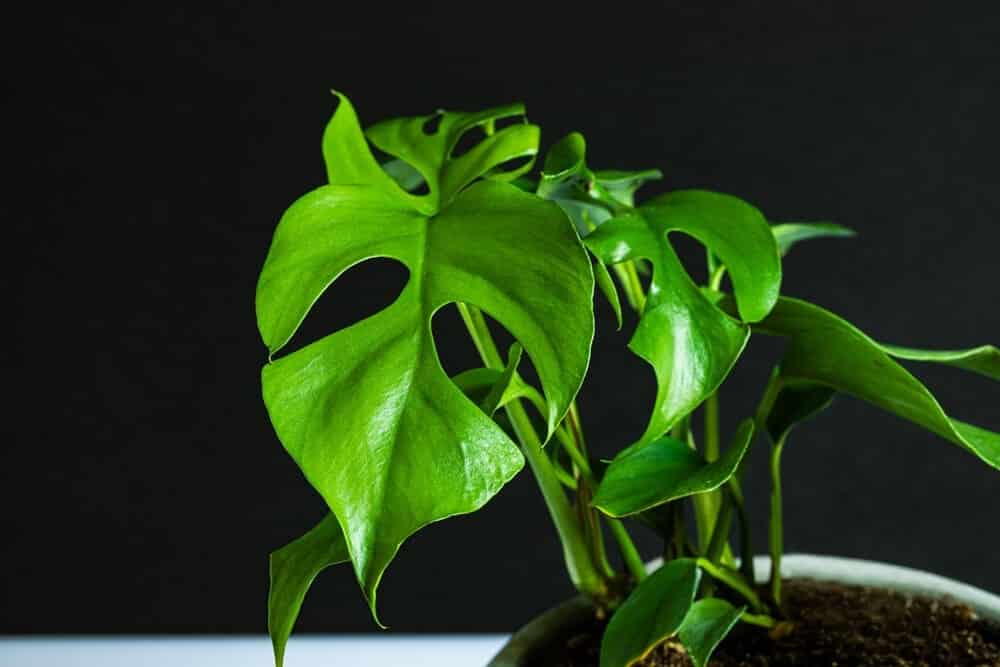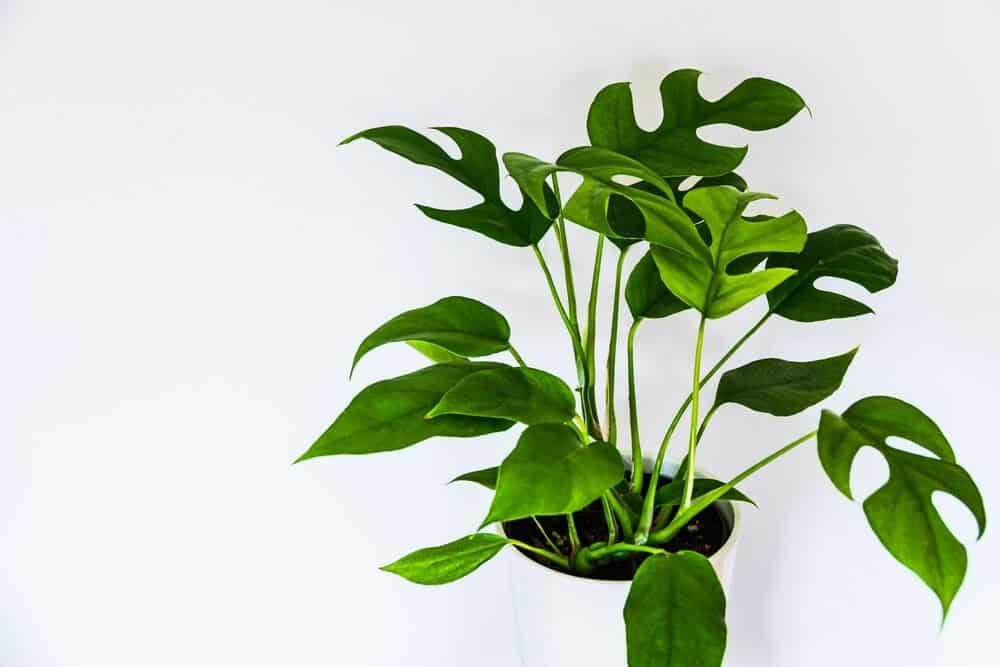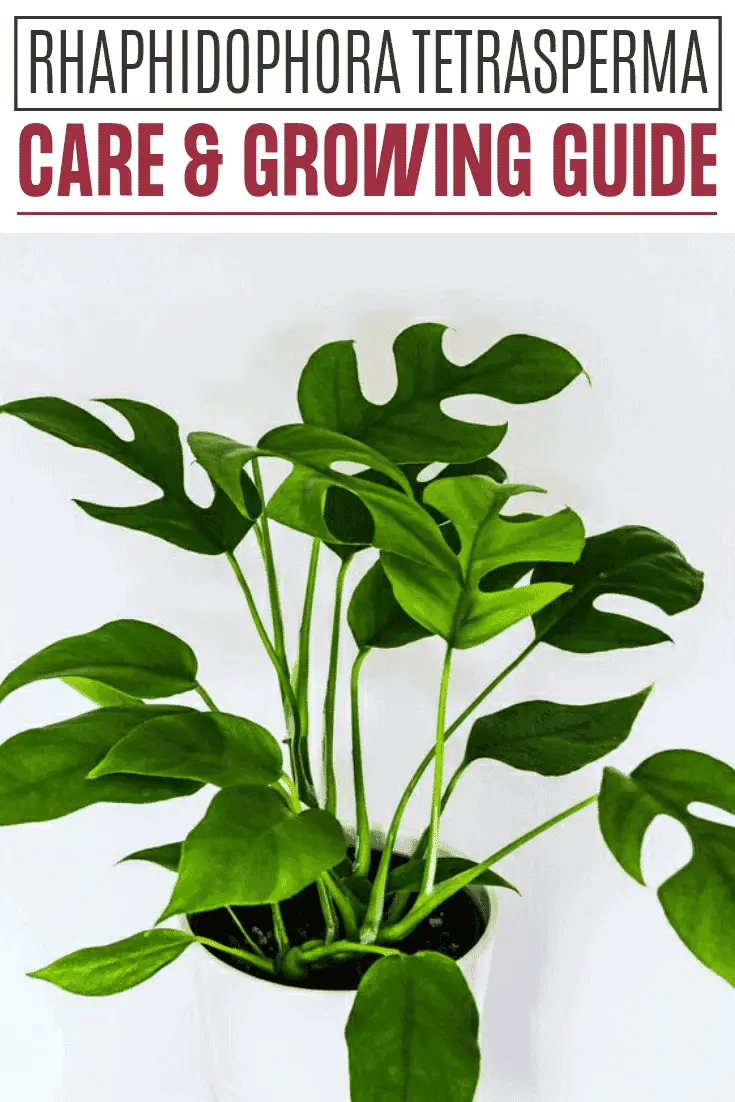With such a long name, one would think the plant has to be unique and strange looking.
And it is! Its leaves are unique and one-of-a-kind and the main feature of this plant. It’s rare to find this plant as a houseplant. It is found in Malaysia and Southern Thailand. Those who buy this plant from greeneries and nurseries will know it by its alternative names, the mini split-leaf or the ginny plant.
Rhaphidophora Tetrasperma Care & Growing Guide
1. Lighting Requirement
The mini split-leaf does well in bright indirect light. Keep it indoors and have it near a large window that allows for a lot of light. It also does well with a little bit of direct morning sun. If the plant doesn’t receive enough light, it’s growth will stunt, and the leaves will become limp.
This plant can live and grow under artificial grow lights as well
2. Water
The tetrasperma plant enjoys staying moist most of the time, but it does not like soggy soil. When the first two inches of the soil turns dry, then it is time to water it again. It needs to be watered more often in the spring and summer because that is its growing season. To protect it from diseases that occur when it’s overwatered, it’s always best to underwater it.
3. Climate and temperature
Since this plant comes from Thailand and Malaysia, it grows best in very humid weather. If it isn’t going to live in a humid area, the humidity around the plant can be increased by setting it next to a humidifier.
If a house gardener doesn’t want to make the room where this plant resides humid, then it can grow in at room temperature and dryness. Its growth rate might slow down, though, but it will be just fine.
If this plant is outside, it does best in hardiness zones 9 through 12, but it should always be brought in the house when it’s cold.

4. Soil
The soil for this plant must be well-draining, so that excess water flows away from the roots quickly. Use regular potting soil and add perlite to improve the drainage even more.
If the soil needs to be fertilized, use one that has a high amount of nitrogen, and only fertilize it during its growing season. Reduce fertilizing two very little or not at all during winter months.
5. Repotting
The Ginny plant needs to have a lot of room for its roots to grow. If the container it is in is crowding its roots, it will not grow well. Make sure it is in a deep container that can provide at least 10 inches of soil.
Because of its fast growth rate, this plant will need to be repotted once a year, maybe even twice.
During repotting, shake out excess soil from the roots and always check it for root rot, since it is prone to root-based diseases. Move slowly and be gentle with the stems and leaves.
6. Speed of Growth
When the humidity is right, and it gets enough sunlight, this plant has a very fast growth rate. It even grows during the winter if it is well cared for. Because of this, its roots grow fast as well, and that’s the reason why it needs to be in a container that is deep.
7. Height and Spread
If left alone, this plant can keep on growing and growing. If it’s kept indoors, this houseplant can be kept at around 6ft as to complement furniture or other plants around it. But if left alone, it can easily grow to 12 ft tall. Because of its long leaves, its spread can reach up to two feet
Because of its height, it is good to add a trellis in the pot to provide structure, so the stem doesn’t wilt over.
8. Trimming
This plant must be trimmed regularly to maintain its size. It is a fast grower and can quickly grow higher and make it harder to trim and manage.
Trimming this plant is easy. Just cut off the stems right where it connects to the main stock. If there is a node on the stem, cut it just before the node.
The vines can be removed just by pinching them off.

Is the Rhaphidophora tetrasperma plant poisonous?
Although this plant is not toxic to humans, it is to pets and other animals. If an animal like a dog were to eat one of its leaves, it could cause vomiting, irritation in the mouth, and excessive drooling. If you suspect that your pet is suffering from this plant poison, then it needs to be taken to the veterinarian.
Can the Rhaphidophora tetrasperma grow in water?
No, this plant cannot be grown in water. It is prone to root-based diseases that occur from overwatering. It would not last long, and it would quickly die.
Does the Rhaphidophora tetrasperma have flowers, and how do I get them to bloom?
No, the Ginny plant does not flower at all. Its nutrition and energy is dedicated to its fast-growing stems and leaves
More like this: Spike Moss (Selaginella) Care & Growing Guide
Common Rhaphidophora tetrasperma Pests and Diseases
Root rot is the most common disease this plant will face. This disease occurs when water is stagnant around the roots, and the weather is warm. It is a fungus that destroys the roots and leaves black mold as it works its way up the stems and leaves. To fight against root rot, a fungicide must be applied to the roots, and it must be repotted in new soil. Cutaway any dead leaves or roots and throw them away.
Spider mites attack plants by sucking out their nutrients and sap from the stems and leaves. If they infested a plant, they could quickly kill it. To fight spider mites, rinse them off of the plant and then apply a light insecticide to keep them away.
Also read:
Conclusion
- The soil for this plant should be damp, but never soak it
- The best fertilizer is a nitrogen-based one.
- It is also called the Ginny Plant or the mini split leaf.
- This plant comes from Malaysia and Thailand.
- It cannot handle full direct sun,
- This plant can grow up to 12 feet tall.
- It does best if the air around it is humid.

Victoria is the owner and main author of hobby plants. She loves spending her free time in her garden planting and taking care of her plants. Victoria hopes you enjoy the content here!